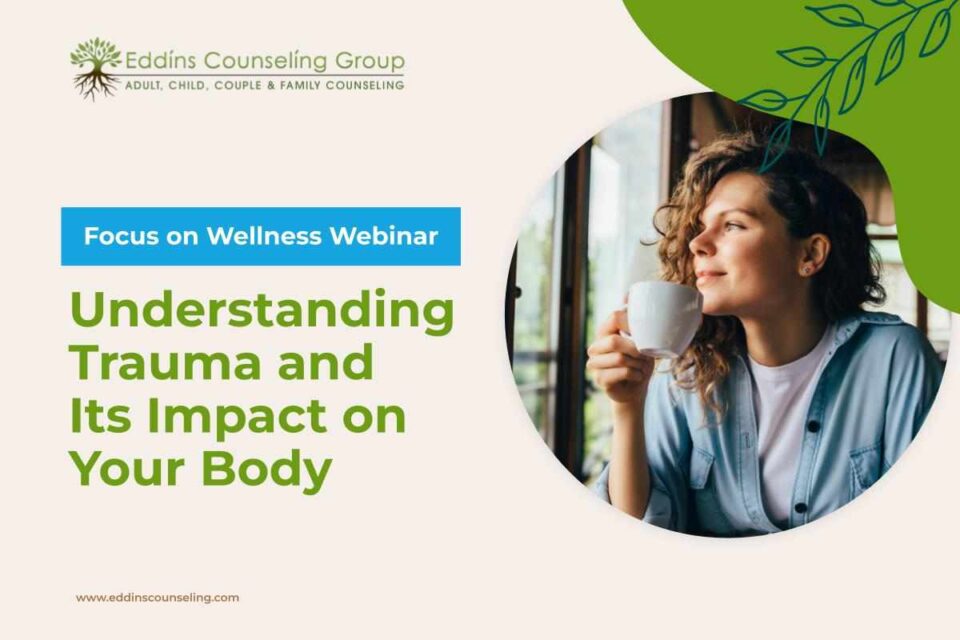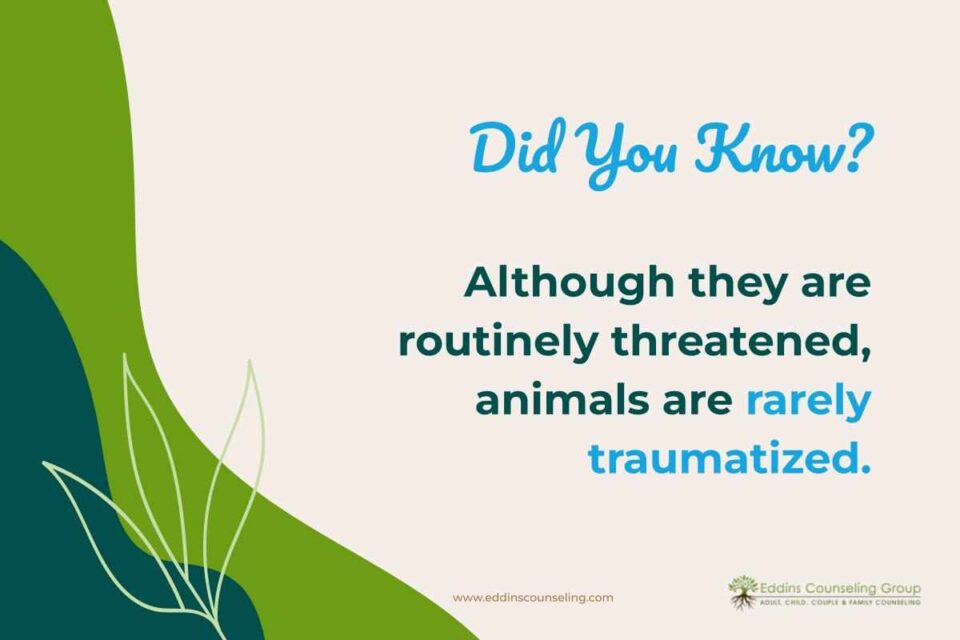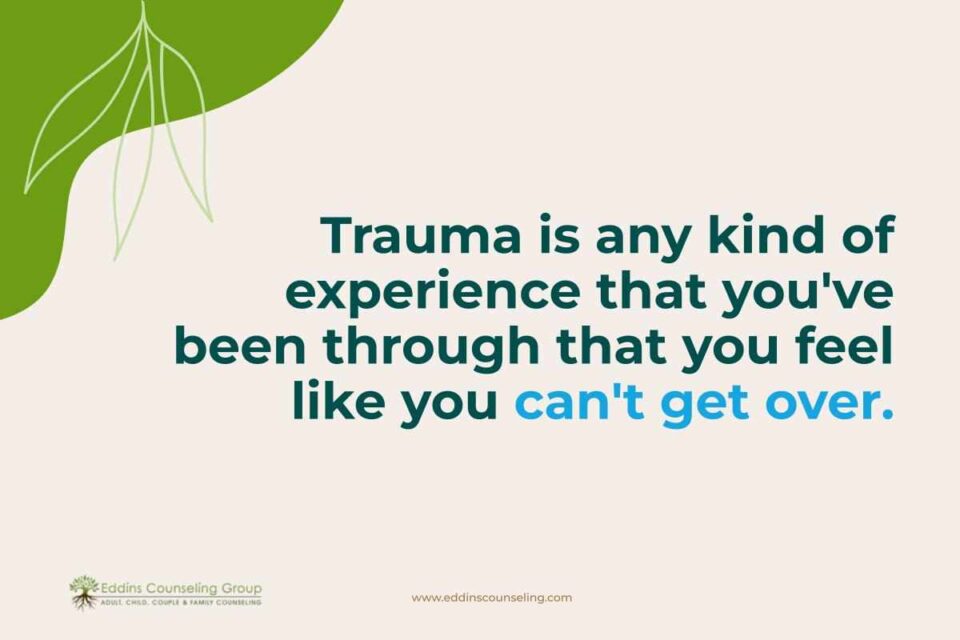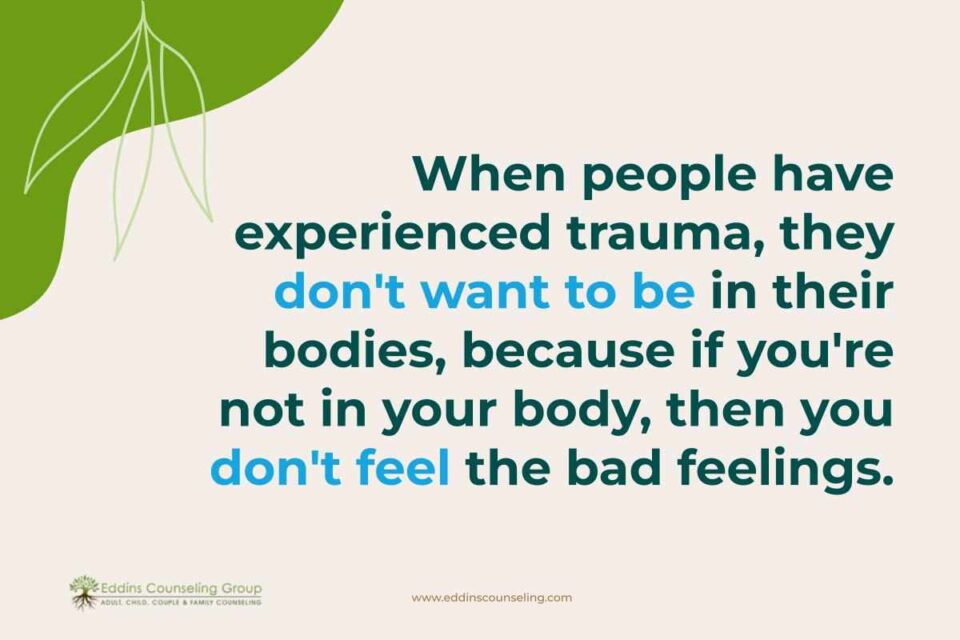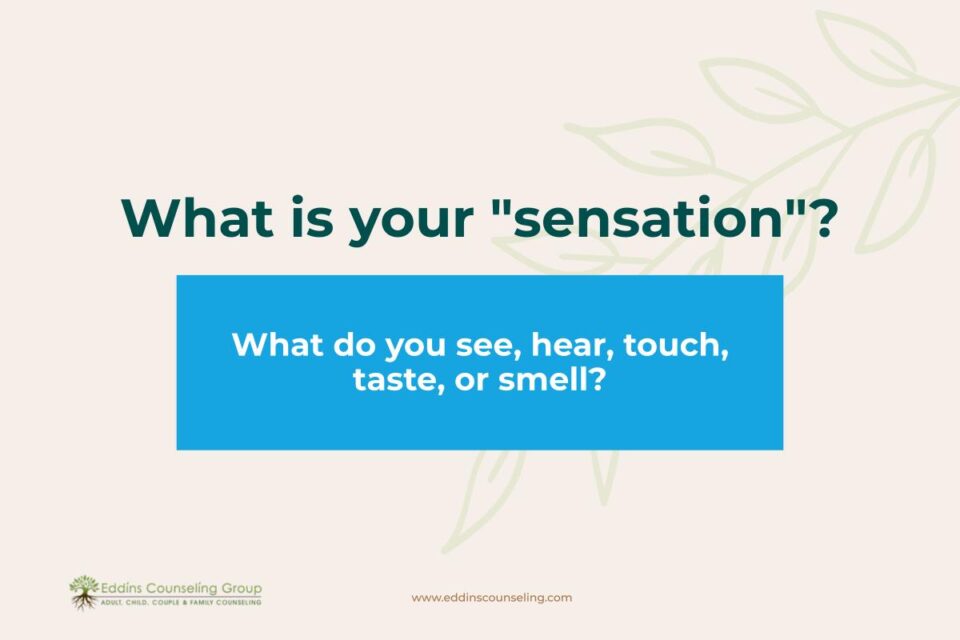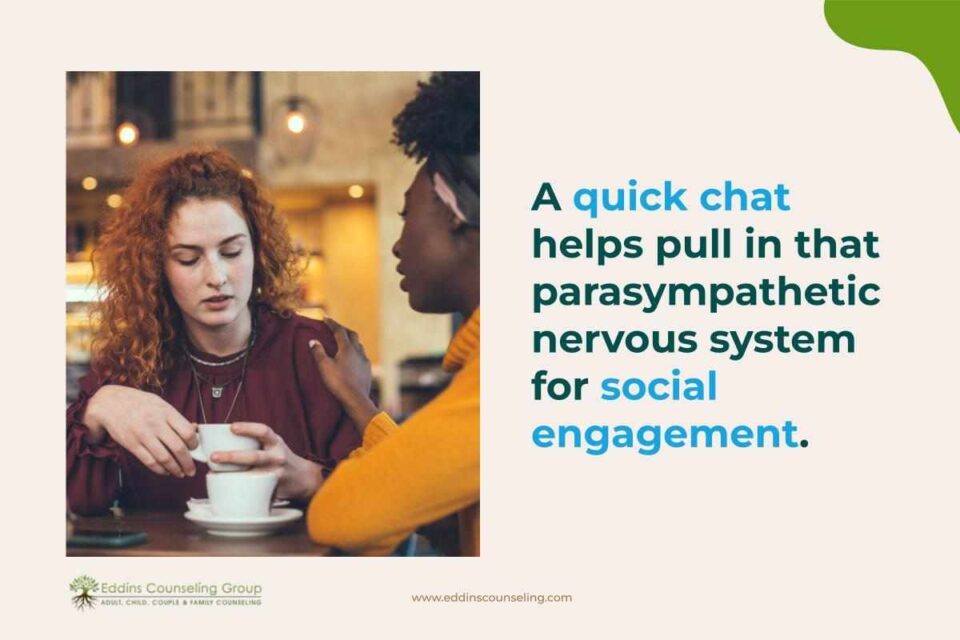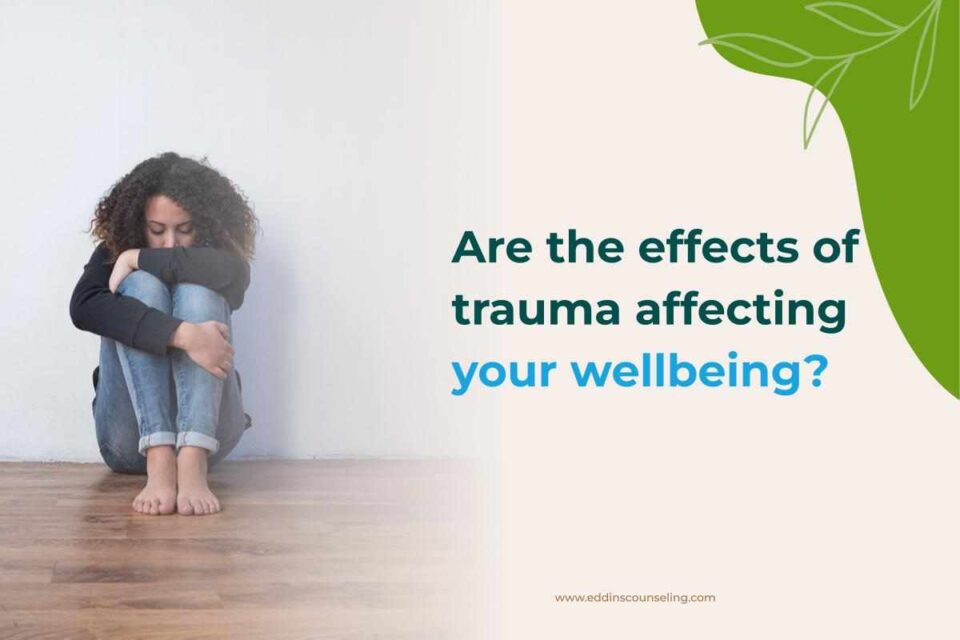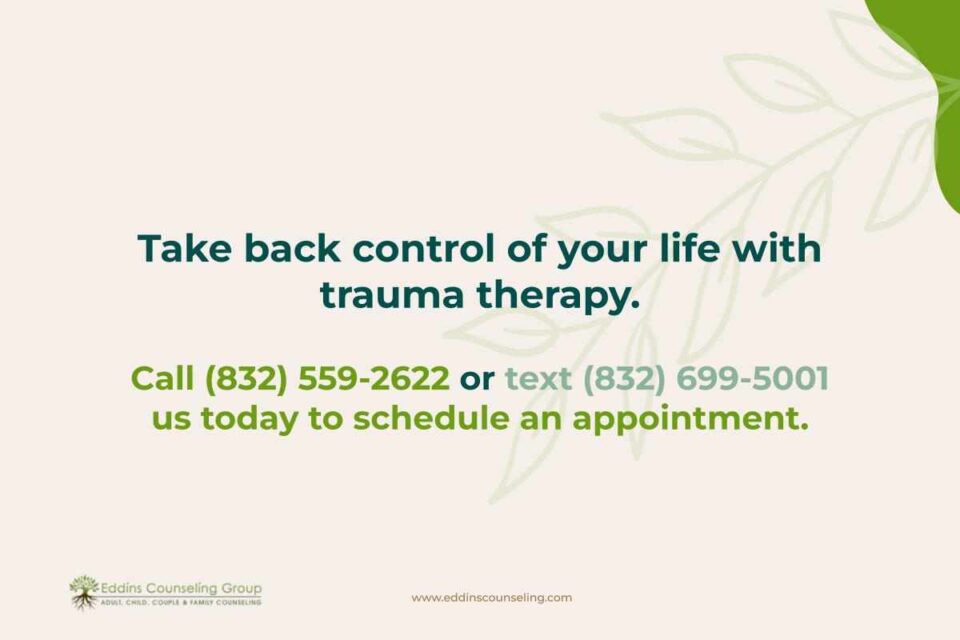March 12, 2020
Webinar: Understanding Trauma and Its Impact on Your Body
Written by Rachel Eddins
Posted in Trauma, Grief & Loss, Webinars and with tags: PTSD/Trauma, emotional trauma, trauma

Trauma lives in the body and can stay trapped causing many emotional and physical issues.
Learn more about how trauma shows up in the body and how to help the body release trauma and relieve emotional and physical pain.
Facilitated by Becky Reiter.
Watch a replay of the presentation here.
Learn more about our trauma and grief counseling services.
Here is a transcript of the webinar:
Let’s get started. Thank you everyone for coming.
If you have a question during my presentation, just type it in the chat box. I’ll be able to see it while I’m talking. I’ve got everybody muted right now and we are recording.
I’m going to talk for about 45 minutes and then for the last 15 to 20 minutes, I’m going to answer some questions that you might have.
I’m hoping it gives you an idea if you feel like you are experiencing trauma, what that looks like, and why it might be happening.
Today you’re going to learn about:
- what is trauma,
- how do I identify it,
- what is the Lizard Brain,
- bottom-up processing,
- the rule of sensation in trauma, and
- trauma healing
What Is Trauma?
Trauma is a breach of the protective barrier against overstimulation, leading to overwhelming feelings of helplessness.
Traumatic symptoms are not caused by the event itself. They’re caused when you have some energy left in your body that remains trapped in your nervous system.
The type of trauma therapy that I do is somatic experiencing. I’m a somatic experiencing practitioner, so if you’ve never heard of that, it was created by Peter Levine. He’s got a couple of great books. One, in particular, is “Waking the Tiger: Healing Trauma”.
When you think about trauma, animals are rarely traumatized. Even though they are routinely threatened, they’re not traumatized because they don’t have that extra higher executive functioning than we do as humans. They can’t say: “Oh my gosh! That predator almost got me. I can’t believe I was so dumb as to be there when I shouldn’t have been.”
For them, for animals, it’s just: “Yay, I got away from my predator!” and they go about their business. They’re just happy they were able to fully complete what they needed to complete. They got activated and had to run and then they were able to escape from the predator.
A Healthy Nervous System

Let’s talk about the healthy nervous system. You can see something we call arousal activation. We hear the word “trigger” all the time. So something triggers you to fight, flight, or freeze. So it activates your sympathetic nervous system.
Your sympathetic nervous system gets your whole body ready for action.
- It regulates arousal.
- It increases activity during times of stress (positive or negative).
- It increases your heart rate, respiration, and blood pressure. So when you’re feeling afraid, or you’re feeling anxious, that might be why suddenly you feel like your heart is pounding. This is because your sympathetic nervous system is activating.
- It’s also shifting blood away from our digestive system to our muscles to allow for quicker movement.
- You may notice when you’re really anxious, your stomach might hurt. It just feels like something’s happening in that part of your body.
- It also constricts our blood vessels and drains the blood away from the skin’s periphery. So that’s why when you feel anxiety, you start to feel pale and cold because it’s taking all of the blood from your extremities and moving it to your larger muscle groups so you can fight or run away.
- It dilates your pupils, retracts your eyelids, and makes your eyes focus. That’s why a lot of times people will talk about, “I was in an accident and suddenly I had this super clear focus of what was happening.”
This is because your sympathetic nervous system is taking care of you. It’s making sure you can run away or escape whatever could be coming at you.
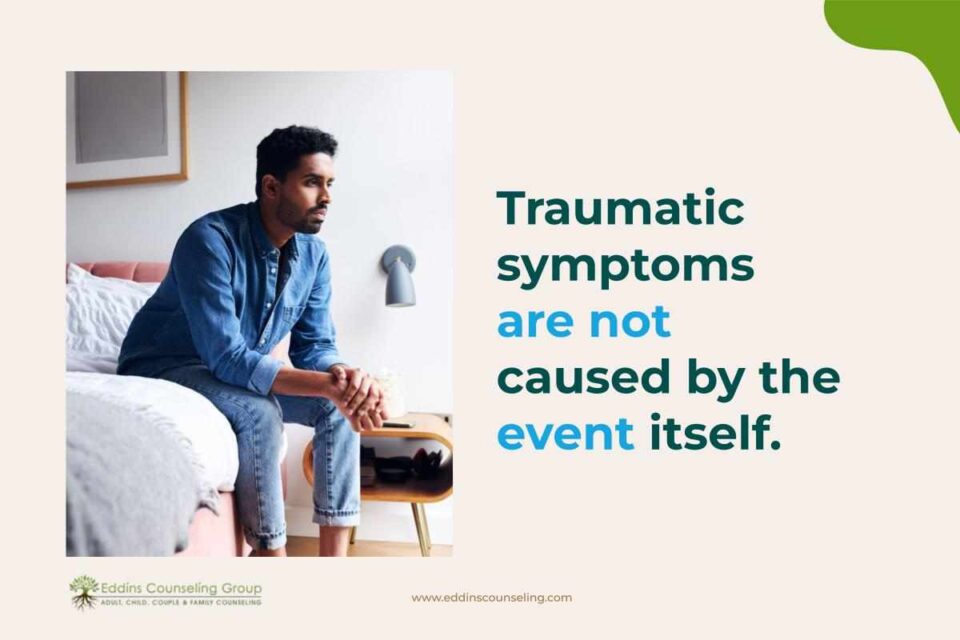
So you get activated and your sympathetic nervous system kicks on, but we can’t operate in sympathetic all the time.
The challenge with that is sometimes when we have trauma, our bodies get stuck in sympathetic.
We’re not able to get the parasympathetic to kick on to do what it needs to help us settle and then recover from the trauma we’ve experienced.
What happens in your body when the parasympathetic kicks on?
The goal is to rest. You’ve probably heard “rest and digest” before. The goal of the parasympathetic nervous system is to help us:
- let go of muscle tension,
- lower our heart rate and blood pressure,
- warm our skin, and return the blush (you have color again because you have blood in your extremities and your skin again),
- aids digestion,
- slows and deepens your breathing,
- returns blood to the peripheral blood vessels back to your extremities.
It also allows your immune system to fully function again and then bodily fluids to do what they need to do.
It acts like a brake pedal for the nervous system.
Also, it helps you relax, unwind, and ultimately do what we call the “discharge of the arousal” of that activation that you’ve experienced.
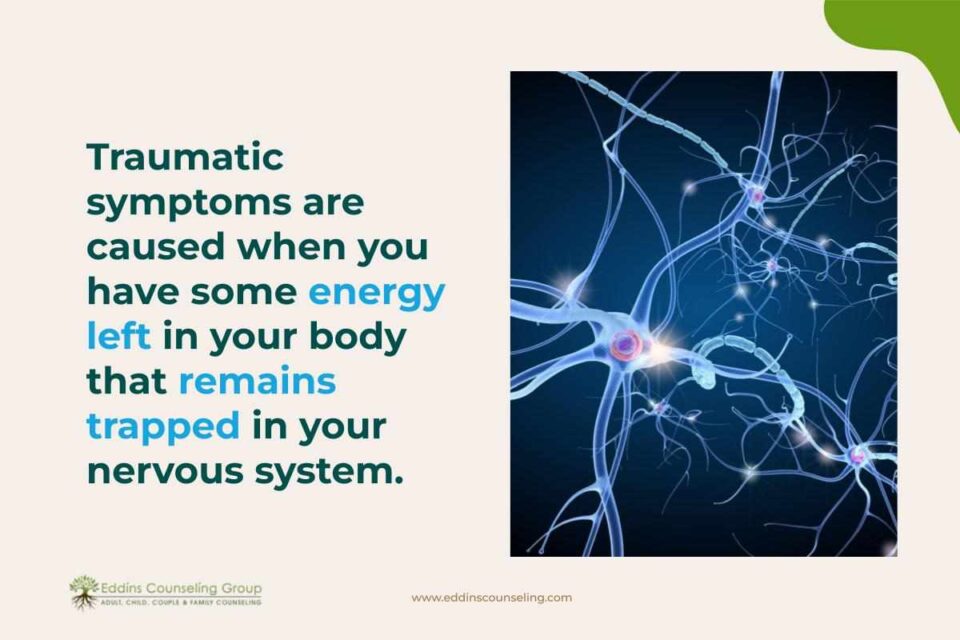
So you get really active, your sympathetic kicks on, and then we want your parasympathetic to kick in so that you can then settle and start the process all over again.
It’s supposed to be a kind of slow wave like you see in the image.
Symptoms of Un-Discharged Traumatic Stress
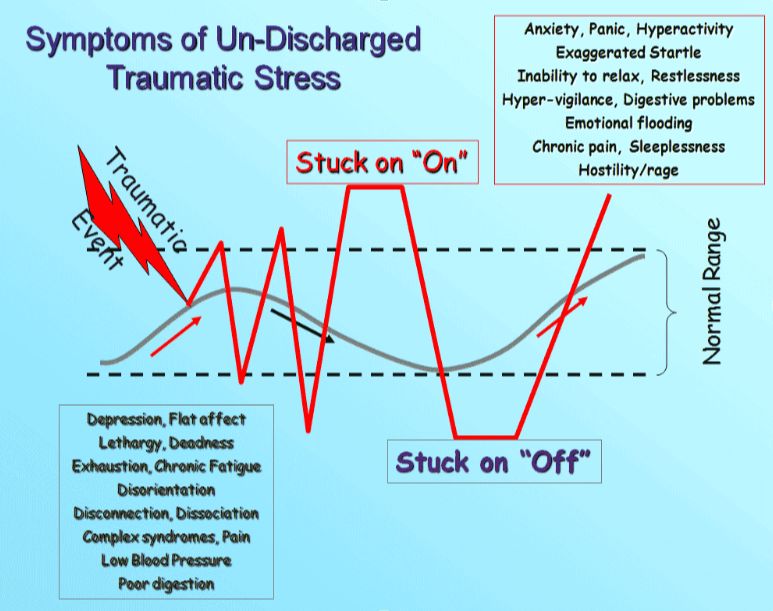
When you have trauma, you can see what happens to your nervous system. You don’t have that nice gentle wave that you’re supposed to have. You’ve got the jagged up and down. You can get stuck in certain areas.
So, you can get stuck on “On” and you’re ready to flee or fight all the time.
You can get stuck on “Off” so that you freeze. Most people have heard of fight or flight, but there’s also freeze.
A great example of freeze is the possum. That’s the reason that they play dead.
A fox may be running after the possum and it’s excited and then the possum lays down and plays dead. And the fox thinks that isn’t fun anymore. It doesn’t get to chase the possum anymore. And leaves it alone.
The possum goes into such a state of freeze that you can’t even tell if it’s alive or breathing. That’s why it looks like it’s playing dead.
For humans, it could be depression or flat affect, so no emotion in their voice when they’re speaking. They’re tired all the time, and very lethargic. Maybe they have chronic fatigue. They dissociate, so they’re not in their bodies.
They might have poor digestion or low blood pressure. There are a lot of things that you can have when you don’t have a healthy nervous system response, especially when you’re in freeze and you’re stuck in “Off”, and you don’t really want to do anything. That typically looks like depression.
For someone who is stuck in “On” and constantly wants to fight or flee, they could have anxiety, panic, and hyperactivity.
Maybe, for example, you accidentally walk by their office and they suddenly jump really big because they weren’t ready for someone to walk by and they weren’t prepared for it.
Their nervous system is set in such a stuck “On” state that any little thing like that is going to startle them. They can’t relax. Maybe they have a lot of chronic pain because of muscle pain. They don’t sleep well.
So if you’re not able to fall asleep or stay asleep, that can be really challenging. People that are stuck in “On” have a lot of digestive issues. They can have emotional flashbacks and flooding where they can get really overwhelmed with emotion very easily.

If your nervous system is stuck in “On”, physically that’s going to be:
- increased heart rate,
- difficulty breathing,
- cold sweats, and
- tension.
- hyper-vigilant, and
- have a lot of racing thoughts,
- panic attacks, and
- rage.
And if your nervous system is stuck in “Off”, it will be:
- low energy exhaustion,
- low heart rate or blood pressure, and
- poor digestion.
- That’s where you have depression, and
- disconnection in your relationship with family members.
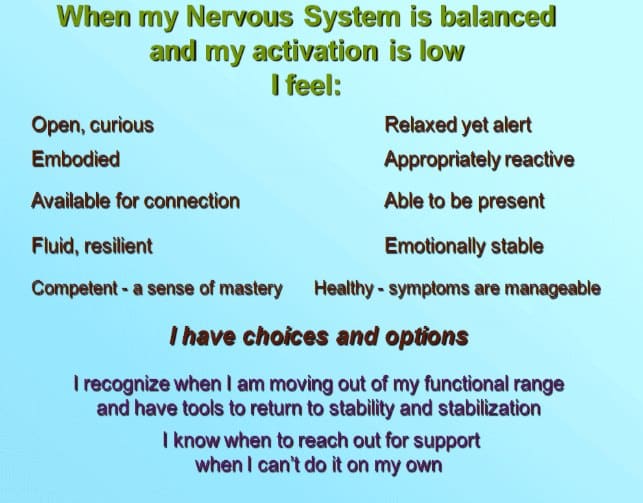
It’s really challenging. Part of the work that I do is helping people go back to what that healthy nervous system should look like. Change so that it’s not so jagged and you have that flow again.
You also are able to feel open and curious instead of worrying that you’re going to be injured or someone’s going to hurt you. You’re more in your body. That’s part of what I do with somatic experiencing, and I’ll talk about that a little bit later.
They have more resiliency. They feel like they have more regulation and emotional stability, and they really feel like they have choices and options and can reach out for support.
That’s what we want a healthy nervous system to look like. Not to be stuck in “On or “Off”, but to have that nice gentle flow.
How Does Trauma Work?
This is the way trauma works: it’s in your body, both your emotions, and the trauma that you’ve been through. Your body is what remember.
Another great book is by Bessel van der Kord M.D. called “The Body Keeps the Score: Brain, Mind, and Body in the Healing of Trauma”.
It has helped a lot of my clients kind of understand what they’re going through and what their experience is like because:
- it can be really overwhelming to realize that you have trauma, and
- you don’t know what to do about it, or
- how to recognize it.
Trauma is any kind of experience that you’ve been through that you feel like you can’t get over.
Or, you feel anxious every time you get called into your boss’s office because you had this experience before where you got called in and your boss was screaming at you. It’s not the event that has caused the trauma, it’s the response to it.
So chances are that person came out of that experience with this negative belief about themselves that they carried forward, thinking they’re incompetent, or their boss thinks they are stupid. And they continue to carry that with them.
Those feelings that they felt when they were being yelled at and then when they were also talking so negatively to themselves has stayed in their body.
So, for instance, kind of going back to that boss example, this person probably didn’t say anything to their boss. They felt helpless, they felt powerless. And there wasn’t anything that they could do to discharge this stressful experience from their body.
It just stayed very contained inside because they may have wanted to yell at their boss or be defensive or flee from the room if their instinct is to flee. But they had to stay there and be yelled at. So their body was unable to do what it needed to do to move through the trauma and discharge it.
So they get stuck “On” and then every time they go to their boss’s office, they feel those same feelings in their bodies as they did when that first experience happened. It gets stuck in the body.
This is why it’s really challenging to use cognitive behavioral therapy with trauma because most trauma starts bottom-up in your brain.
So in your brain, you’ve got the reptilian brain, you’ve got your neocortex, your thalamus, your limbic system. There are all these different parts of your brain.
The Reptilian Brain
The reptilian brain is the very bottom of the brain. It’s the one that governs digestion, circulation, breathing, and “fight or flight”.
So if you’re trying to work with the neocortex where all your cognitions are, you can get very stuck. You can understand cognitively in your brain: “Okay, my boss was having a bad day. It wasn’t my fault. I don’t need to carry this.” But your body still holds onto it because it never got to finish what it needed to do.
Just like when I was talking about the animals.
The gazelle is being chased by the tiger and you see the gazelle get away from the tiger and it kicks its legs in happiness because it escaped.
It doesn’t have that extra layer of thinking: “I should have known better than to be in that area where tigers typically are.”
Same thing with the possum. The possum goes into “freeze” and it doesn’t get eaten by the fox. It’s able to fully complete that wave that you see in the healthy nervous system. So it’s able to get activated.
That sympathetic nervous system kicks on to help it get away. Once it’s able to settle and the parasympathetic kicks in to help it settle and rest, it’s been able to discharge the trauma that the animal experienced.
That’s how we are different from animals.
Animals work predominantly from the reptilian brain or the lizard brain and don’t have that higher level part of the neocortex that has the cognitions.
The lizard brain is our primitive brain. It governs our instincts and our reflexes. That’s the part of our brain that teaches us “fight, flight, or freeze”. It’s the part that chooses: “What am I going to do in this instance right now?”
The Lizard Brain
Because trauma in our experience starts with that part of the body or that part of the brain, that lizard brain that’s so instantaneous (I need to run or freeze or fight), the language of the reptilian brain or the lizard brain is sensation.
I’m going to go into a little bit about that because it can be kind of confusing. Traditionally counseling and therapy have been based on cognitions. How can we change your thinking?
I work with a lot of people who have chronic pain or chronic conditions that the medical community cannot explain. They’re telling them that “We don’t know why you have this. There’s no bodily problem that we can see”. It’s because the trauma gets stuck in the body and this is how it’s trying to keep someone safe.
So, for instance, anxiety, if you notice you have anxiety or panic attacks. Anxiety feels awful, but it’s also meant to protect you.
All of these things that we’ve developed over time, including anxiety, depression, and anything that you can find that’s considered a mental illness are made to protect us.
Same thing with what we call psychosomatic illnesses. Something where there’s no physical medical cause, but the body, the brain is still taking over and causing these things to happen. It can cause chronic fatigue, low blood pressure, or poor digestion because it’s stuck in “On” or “Off”.
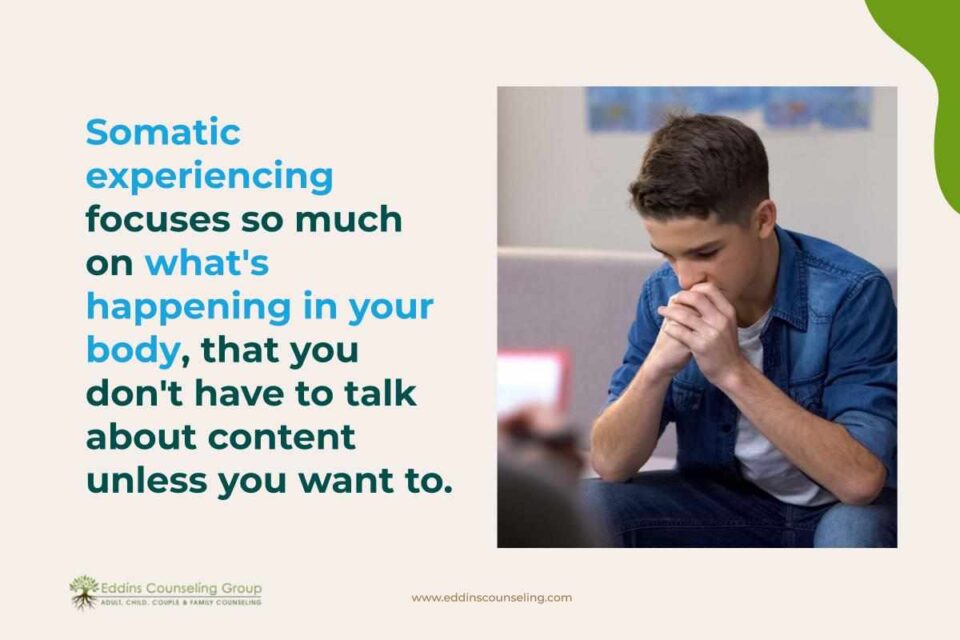
Somatic Experiencing
Somatic experiencing is a method for resolving trauma. It:
- resets the nervous system,
- restores interbalance,
- enhances your resilience for stress, and
- increases your vitality.
One of the first things that I start doing with so many of my clients is helping them increase their capacity. So, for instance, most people are able to feel anxiety in their chest, throat, neck, or shoulders. Maybe they will get headaches. Those are some really good examples of where you’re kind of wondering where is this coming from.
You have the whole rest of your body to utilize to manage those symptoms of anxiety.
If you’re mainly trying to work with a small capacity, when more anxiety happens or more things happen to you, you get even more overloaded.
So you’re already stuck on “On”. But this might be where you get to another level. You have panic attacks.
You have, what I like to call anxiety meltdowns. This is where you might end up crying in the bathroom for hours and you feel like it’s not something you can manage or something that is going to last a short amount of time.
Sensation
Somatic experiencing works with the body – works where things are stuck – because of your lizard brain. The language of that is sensation. When I start working on increasing capacity, I like to start working with sensation.
This is because number one when you’re using your sensation, that’s where if you’ve been to any kind of counseling before and they talk about grounding, we ask you to use your five senses.
- What are things that you can see?
- What can you smell?
- What do you taste?
- What do you touch?
- What can you hear?
It’s called grounding because it brings you back into your body.
So I use that, but take it to a whole higher level with trauma. For someone who is struggling with trauma, something that I would recommend you utilize to help yourself is going to be sensation.
You want to work on that “felt sense” that you have as a human and be able to turn that inward.
“Felt Sense”
We start with the “felt sense”. We start with those kinds of external things like “my chair feels really soft”, or “I can feel the rough concrete under my feet or the grass in my toes”.
What do I see to really engage that lizard brain to be in your body?
Once you’re able to connect with those types of sensations, then you’re able to connect the sensations that are happening in your body and what emotions they are.
For instance, whenever you feel anxious and you have a lot of stomach trouble, and you’re thinking: “Why is my stomach so upset today?” You’re noticing what’s happening with your stomach, and you might go: “Well, that’s just because I ate something bad last night”, versus “Maybe I did eat something bad, but then I also got into a fight with my spouse”.
And maybe that’s carrying through to the next day where you have a lot of stomach discomfort because you didn’t resolve the fight. You’ve had fights before, and it’s really uncomfortable, it makes you feel anxious. So your stomach feels really upset, but you don’t get to that part yet. That can take a while.
Noticing the Sensation
I’m noticing the sensation and am curious about it. So when I talk about noticing sensation, we don’t want it to be negative or positive.
We don’t want anybody to put a judgment on the sensation. It’s just there. Be curious about it. You can be open and curious.
When people have experienced trauma, they don’t want to be in their bodies, because if you’re not in your body, then you don’t feel the bad feelings to the extent that you would if you were fully embodied.
And that can be a challenge.
I remember, even for myself, having my first somatic experiencing session with the therapist and thinking: “I’m pretty good in my body. I can feel my feet and my toes, and whenever I touch things.”
But until I did my session, I didn’t realize how much I wasn’t feeling my body, because the therapist would ask me:
- “What’s happening in your body right now?” >> “Oh, I’m feeling sad”.
- “Well, how do you know you’re sad?” >> And that was really hard for me to answer. I really had to stop and turn inward. This is like the example of anxiety in your stomach.
Does it always mean just because your stomach hurts, that you ate something that didn’t agree with you? Could it also be linked to other things? You can link those symptoms and be able to make meaning about what’s happening to you.
Again, because sensation brings up emotion, it can be really hard to stay with that. So anytime you’re practicing sensation and really noticing what’s happening in your body, you have to do it a little bit at a time.
Something I like to stress is that no one is ever going to be perfect.
I am not perfect. Even if you’re able to notice the sensation in your body that you’ve never been able to notice before, but you’ve only been able to do it one out of ten times that you’ve tried, that’s still a success. That is still progress.
The more that you are able to connect with sensation instead of your body having to scream at you. Typically what happens is it’s not just a little stomach upset, it can get really bad. Maybe you’re having a lot of muscle pain because your neck and shoulder muscles are so tense that you can’t move your neck anymore.
The reason why noticing sensation and noticing the nuances of sensation is so important is it’s better to notice it earlier before your body has to start screaming at you that something is wrong.
Emotions live in your body and if you’re not able to listen to it because it’s too uncomfortable, it’s going to start screaming at you, and then you’re going to be even more uncomfortable.
Some of the goals for sensation are to slow down the nervous system. I mentioned this at the very beginning, but trauma happens because of too much, too fast. So we want to slow things down.
Trauma and Your Nervous System
Trauma overwhelms your nervous system and in order to help your nervous system work it through, it needs to be so much slower.
This is also why trauma work can take a lot of time. Any kind of counseling and therapy can take a lot of time because your body needs time to work through it.
It needs to be able to slow down so that we can broaden the awareness of your bodily experiences:
- to be able to access the sensation,
- to be able to process through the trauma, and
- to use your body to process that trauma.
Anxiety and panic attacks feel like they happen immediately. Depression is hard too because someone might notice symptoms of depression, of feeling sad or lethargic and just think they had a bad day, or they’re just tired until the day comes that they can’t get out of bed.
It’s such a challenge and that’s why it takes a lot of time. I like to joke and use cliches that Rome was not built in a day.
Trauma also was not built in a day or in one instance. It was built in multiple instances.
If it’s pervasive trauma, for instance, or different types of trauma that people don’t always think is trauma would be developmental trauma. So if you had less than nurturing relationships with your parents, that can be traumatic. That can create a lot of issues with anxiety.
Avoidant attachment is a type of trauma where maybe your parents did not tell you they loved you or they never hugged you or if they touched you, they only touched you in anger, you were only spanked or hit, or things like that.
It doesn’t have to be something huge and overt to be traumatic.
Big “T” Trauma vs. Little “T” Trauma
Most people think of trauma as going to war or being in an accident or being assaulted and those are all that we call big “T” traumas.
And if they’re singular experiences, that’s a big “T” trauma. And so then you have the little “T” trauma, which is the developmental trauma and includes anxiety, panic attacks, and shame which is a big one.
If you grew up with parents that were very shaming and telling you “you’re a bad girl” or “you’re a bad boy” versus, “that’s bad behavior”. That can create trauma where you have a lot of fear of always getting in trouble. You have shame about never feeling good enough.
Panic attacks are also traumatic all on their own for a lot of people.
Working to slow things down and track the sensation that’s happening in our bodies gives you more choices because when you’re sitting and being yelled at, you can’t get away. This is versus if you were able to slow that down and think about what your body wanted to do.
Maybe you feel your legs wanting to move. Then we would really notice the movement that’s happening in your legs and what it might need to do. Maybe you need to get up and walk around or maybe you’re in your office and you need to just walk out for a moment and really notice the sensation that’s happening inside your body.
“If I notice the movement in my legs,
- am I feeling some anxiety?
- Is my heart pounding?
- Does my chest feel tight?
- What happens when I actually get up and leave my office?
- Do I feel that maybe the tension in my chest relaxes, my shoulders dropping?”
Noticing those sensations when you’ve actually been able to feel the trauma experience and then mobilize your body to fully complete your experience.
Social Engagement
One of the top ways of helping yourself when you feel a trauma trigger happen is what we call social engagement. So while it may seem like you don’t want to be around anyone while you’re feeling this way, it’s one of the easiest and fastest ways to pull yourself out of trauma.
You don’t necessarily have to go and be part of a big group, but maybe going down the hall and talking to a coworker, calling or texting a friend to where you can kind of pull yourself out of that trauma. This is not ignoring it. It’s at a point where you can’t feel it any longer or you’ve been feeling it for too long and so you need to shift out of that.
Pendulation
So if you come to my office and we have a 45 minutes session, we’re not going to spend that entire 45 minutes talking about or even feeling this horrible trauma that happened to you.
We’re going to talk a little bit about the trauma and then we might talk about your weekend or talk about some friends that you maybe just saw and had a great experience with.
That’s what we call pendulation and we’re going to titrate the trauma. So we’re going to take little chunks (of your trauma) at a time and not have a 45 minutes session where you’re just sitting and talking about or feeling your trauma.
It may be we work with sensation for as long as we can handle it and then we move into something that feels more positive, that gives you a sense of embodiment and empowerment, and a resource to help you feel better about what you’re experiencing at that moment.
Then we might go back into the trauma.
The nice thing about somatic experiencing is because you focus so much on what’s happening in your body, you don’t have to talk about content unless you want to.
It is helpful sometimes to have an idea of what it is that you experienced or what caused the experience. But most of the time I really like to focus on what’s happening in your body at that moment.
- Are you feeling pressure in your chest or tightness?
- Is your throat really tight because you want to tell me everything that happened?
- Do you want to yell? You were never able to yell back.
Say, for example, your parents yelled at you all the time and you just had to stay quiet because if you yelled back you got in so much trouble or the abuse became worse. That also can be very traumatizing for someone.
Again, I call it pervasive trauma. But it could be even little things where maybe your mother makes little snide comments about your appearance. We call that 1000 paper cuts. But those 1000 paper cuts, all of those link together to cause trauma in your body.
Because every single time she says something negative or painful, your body feels that and holds it because you were never able to do anything in that particular experience to be able to go move through that healthy way of experiencing trauma.
I want you to be able to leave this talk with something you can do on your own. One of the big ones is if you feel very triggered or upset, or you feel your sympathetic activation, click “On” and you want to try to help yourself settle and get your parasympathetic nervous system activated. One of the best things you can do is social engagement.
When I talk about social engagement I’m not talking about Facebook or Instagram.
Facebook and Instagram are very numbing. They help you do what’s called “dissociate”. So dissociation is something everybody experiences it. If you’ve driven somewhere and say you’ve driven there ten times and then this is the 11th time that you’ve gone and you get there and you’re like barely remember your drive. That’s a typical type of dissociation.
The extreme type is called basically used to be called multiple personalities, but it’s now dissociative identity disorder. A lot of us have just kind of a general level of dissociation. It’s when it becomes more that it becomes a problem. But in our society, everybody is on social media and it is where we get a lot of our information.
But if you notice, you’ll start just kind of scrolling and you’re not even connected to what you’re seeing, what you’re reading. You’re not in your body when you’re just kind of randomly scrolling. That’s a way to dissociate and not be in your body so that you don’t feel your feelings. That happens a lot when people have had a bad day at work.
When I talk about social engagement, I mean particularly engaging with another nervous system. So this means:
- talking to your spouse,
- calling your parents,
- calling a friend,
- texting with friends,
- talking to a neighbor, or even
- chatting with the pizza guy if you have pizza delivery.
A quick chat helps pull in that parasympathetic nervous system for social engagement.
Another recommendation I would have would be to start getting used to using your “felt sense”. That’s everything that you can see, hear, touch, taste, or smell.
Really focus on what that feels like and describe that sensation for yourself. Probably one of the hardest things when I start working with a client on sensation, is the vocabulary we don’t have.
It’s not part of our society to say “I feel sad and I know that because my chest feels very heavy”. Getting used to different types of sensations and how you might describe them, and then turning internally and noticing what that feels like in your body.
So if you’re thinking you’re kind of down today, take a moment to stop and think why is that, and how do you know that? And again, it can be very painful sometimes to check in on that. And so that’s where I don’t want you to sit there for very long.
You want to do little bits at a time. If you’re feeling something that’s upsetting or activating to your nervous system and trying to notice those sensations, 15 seconds, 30 seconds. It doesn’t have to be 5 or 10 minutes. And again, you’re not going to do it right exactly how you think you should do it every single time. One time out of ten times is still a success. Really getting to that language of sensation in your lizard brain can help you process trauma.
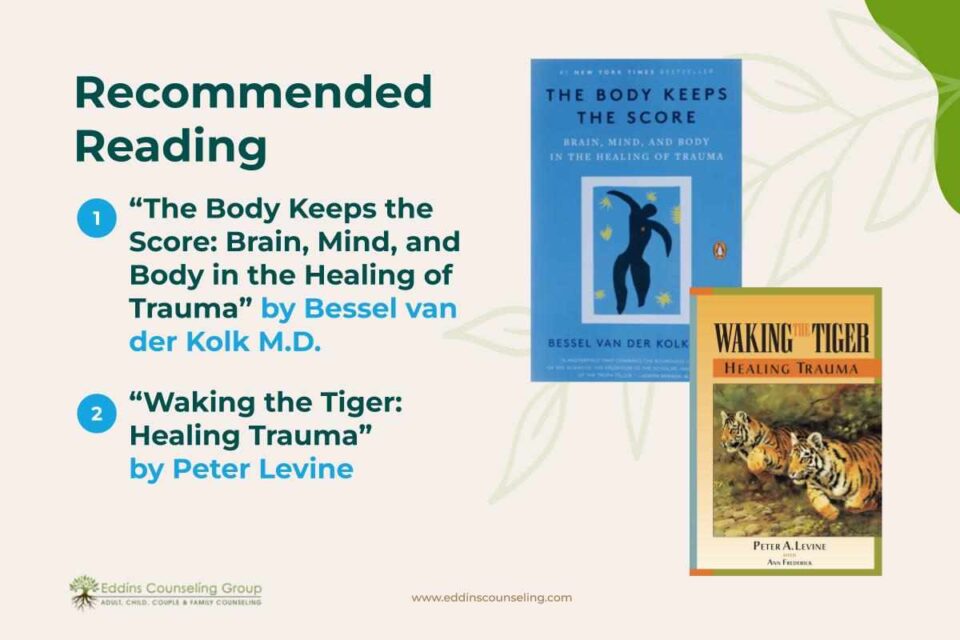
Recommendations
These are the two books I recommended in the presentation: “The Body Keeps the Score: Brain, Mind, and Body in the Healing of Trauma” by Bessel van der Kolk M.D. and “Waking the Tiger: Healing Trauma” by Peter Levine.
Peter Levine is the one who developed somatic experiencing. It’s a three-year certification process that I just finished in October.
I took a very complex issue and trying to bring it down to 45 minutes is a challenge. So please don’t hesitate to reach out if you have any questions or comments or really want to talk to me and see if Somatic Experiencing is right for you. I strongly recommend you grab a couple of these books.
Questions
What’s a good way to shift out of focusing on those sensations after you’ve accessed it for a short period of time?
That can be a challenge, especially if you find that you tend to really hyper-focus. If you’re doing a lot of internal sensations and looking to see what’s happening in your body, that’s where you can shift out of that and change the sensation. So that’s where you’ll use a lot of your “felt sense.”
Maybe start kind of feeling what your desk feels like, noticing that it’s smooth. We don’t want you to go and look internally and really drop deeply into it, but notice a little bit of time happening when you kind of focus internally. That way you’re not spending half an hour noticing how sad you are and then you start crying. And you can’t stop crying.
If you’re noticing you’re focusing internally, it’s okay to cry, but cry for a little bit until you feel like maybe you get to a good stopping point.
Or if you can’t, that’s where kind of “shifting where your focus is” can be really helpful.
A lot of people will ask me: “So you want me to distract myself?” It is a form of distraction because it’s taking you out of the uncomfortable sensation, but it doesn’t mean you’re never going to go back to it. What I want you to do is just notice the sensations as they come up. Don’t make a judgment, just notice that your chest feels tight. Notice what that really feels like before you go into: “My chest feels thigh. That must mean I’m anxious. What could I possibly be anxious about?…”
And then you fling yourself off the cliff into anxiety, or I like to jokingly call it “fall into the rabbit hole”. And so again, it’s being very focused about only going to step into this for 15 or 30 seconds, or as much as you feel you can handle to help kind of move yourself out of that and then just look at something else, do something else, engage your hands with cooking or something like that.
How much is known about imposter syndrome, but would it be related to developmental trauma?
Imposter syndrome can be challenging because it also depends on how you describe it. Imposter syndrome typically is not feeling good enough. Typically, when you have low self-worth or just not feeling good enough, that could be for multiple reasons.
Maybe your parents didn’t necessarily say that you aren’t good enough or they weren’t telling you you weren’t doing well. Or, maybe they never told you you did well and so you never knew if you were actually good at something. I mean, maybe you made good grades, and things like that, but you didn’t have that external person saying: “We really care about you and you’re doing a great job and we really love you”. So it really could be related to a lot of things.
It is accurate to kind of assume it could be related to developmental trauma. And it wouldn’t always have to be a parent. It could be anyone who is primary in your life, a grandparent, a sibling, or a teacher. This happens you don’t feel good enough or you feel like people are praising you when you don’t deserve it and you kind of doubt what they’re saying to you because you’re not able to fully embody that sense of self.
I hope that makes sense because that’s a tough one. Imposter syndrome could look so many different ways for people, but it’s typically a lot of not feeling good enough and potentially feeling a lot of shame, which can definitely be related to developmental trauma. Is it always? Not completely sure, but it would make sense if it is.
Is exposure-type therapy no longer the preferred treatment for anxiety traumas?
I look at Somatic experiencing as my trauma foundation, and I am also trained in EMDR. I look at EMDR as a tool. EMDR is Eye movement desensitization and reprocessing. So it does have that part where you get highly activated and then it is trying to desensitize those feelings of activation around a particularly traumatic incident.
However, because you are activated at such a high level for such a long time, it can be traumatizing for some people. It can cause a lot of emotional dysregulation. And so that can be really challenging for a lot of clients because if they are not stable enough or don’t have enough resources to be able to regulate their emotions, they can have a traumatic EMDR experience. They can have a traumatic exposure experience, especially if it lasts for a long time. It’s a long session. It also depends on their response to the session.
I don’t prefer to use any kind of exposure type of treatment for anxiety because I don’t ever want to retraumatize a client. So those kinds of things can be retraumatizing. I definitely feel my Somatic background now has made me a much better EMDR therapist. But I do prefer somatic experiencing for most traumas.
I might use something like exposure or EMDR for a single-event trauma. Like if someone’s ever been in a car accident for the first time or someone that has only had a few panic attacks or a single incident of assault.
I’m more likely to use EMDR for something like that versus more of the developmental traumas or multiple assaults or multiple accidents or even multiple falls. I’m more likely to use Somatic experiencing for that because I never want to retraumatize someone. I feel exposure therapy can sometimes retraumatize people.
Thank You
I really appreciate all of you. I know it was kind of a last-minute change, but we want to keep everybody safe and we didn’t want anybody to miss this presentation because they were uncomfortable coming to the office or anything like that. So I really appreciate your understanding of changing it to a webinar.
I’m just so thankful for everyone’s participation and interest in this topic because it can be really challenging. I consider myself a trauma specialist, and I absolutely love working with it. So I’m excited to share my experience with everyone.
All right, well, it looks like I don’t have any more questions coming right now, so I’m going to go ahead and finish the webinar for now. I hope everyone has a great evening. Stay healthy, stay safe, and definitely please reach out if you need anything. Thank you so much. Have a great evening.
Are you struggling to recover from trauma? Trauma therapy can help you heal.
Grounding & Self Soothing
Get instant access to your free ebook.

